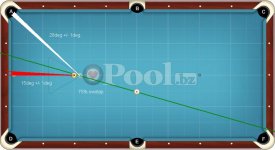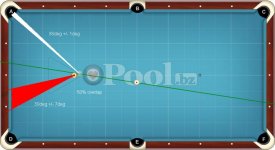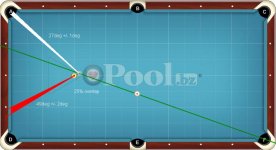I was looking at some of Dr. Dave's proofs and noticed something interesting. I'm sure that most of you know about this, but at least myself and one of my friends didn't, so I'll share.
I did some calculations to see how much aiming error I can play with and still scratch from the foot spot. The cue ball trajectory (of a naturally rolling cueball) after a collision with another ball peaks out at about 38 degrees as a function of OB angle. This peak is right around a half ball hit (30 degrees for OB). For a +/- 1 degree variance in the post collision cue ball angle, the OB has a variance of +/- 7 degrees. This is pretty big.
What this means, is that in the attached pictures, you can hit the object ball into any part of the red zone and the cue ball will always end up in the white zone. The exact angles may vary from table to table, but the idea is the same.
This must be one of the reasons why I see carom players aim for the edge of the ball often.
I did some calculations to see how much aiming error I can play with and still scratch from the foot spot. The cue ball trajectory (of a naturally rolling cueball) after a collision with another ball peaks out at about 38 degrees as a function of OB angle. This peak is right around a half ball hit (30 degrees for OB). For a +/- 1 degree variance in the post collision cue ball angle, the OB has a variance of +/- 7 degrees. This is pretty big.
What this means, is that in the attached pictures, you can hit the object ball into any part of the red zone and the cue ball will always end up in the white zone. The exact angles may vary from table to table, but the idea is the same.
This must be one of the reasons why I see carom players aim for the edge of the ball often.


